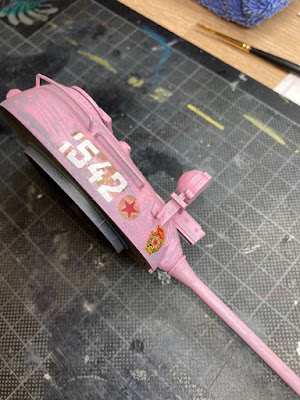Just around the time I wanted to start dirtying up the Battlestar Galactica (and the T-55, see lower), I saw a video by Mig Jimenez about the "Shaders" product line.
It looked to be a (supposedly) easier technique than using oils - which would have been my original approach - but I liked what I saw and decided to give it a go. I needed to order some stuff anyway and at 2-3 euro per shader, I wasn't going to break the bank.
For quick reference, here's a before and after picture.
I started with "starship filth", but it didn't apply as easily as the video had made it seem. The Galactica was varnished with a semi-gloss (i.e. satin) and while my trigger-control on the airbrush is now more controlled than in the past - partly made easier by having a new and better airbrush - the water-based shader did have a tendency to spider away at times. It's easily removed with a paper towel (or finger if you're too lazy to get one, like me) but still a nuisance.
On a piece of paper, I could control it 100% for ultra-thin hairlines from a distance of just 1 centimeter, but on the model (too smooth?) I couldn't manage anything smaller than a millimeter because I had to stay too far from the surface to avoid spidering.
Tip-dry also reared it's ugly head for the first time in years, but it remained tolerable.
Some more detailed pictures. The effect is subtle in some places, more pronounced in others. Mostly visible on the armour plating (especially around the round decal) and in the center of the engine pods (Can we call these nacelles? Or is that restricted to Star Trek?)
After the shader, I wanted the panel lines to pop a little more, so I went over the entire model with a dark panel line wash.
I think I should have sealed in the shader with varnish (or just waited longer for it to fully cure), because here and there the wash "re-activated" the shader (I know that's not the right word). But the resulting smudges were actually ok to look at.
I think I should have sealed in the shader with varnish (or just waited longer for it to fully cure), because here and there the wash "re-activated" the shader (I know that's not the right word). But the resulting smudges were actually ok to look at.
The following pictures have panel line wash on the right, nothing yet on the left.
Meanwhile, the T-55 had been sitting on a shelf for a long time and the decals had discoloured. I tried lightly sanding, but the discolouration is on the inside and sanding only "weathered" the decal in a way I didn't like.
I picked a light rust shader to start. I first varnished it with a matte varnish, hoping that a more matte layer would be better to avoid spidering, but when I went in extremely close to the model, trying for very thin rust-streaks, spiders were back and again I couldn't manage the hairlines I desired.
I settled for what I could achieve and went around the model in a way I hope will look realistic, assuming weld seams would be more susceptible to rusting than flat surfaces.
If I give shaders another go on a future model, I'll try a flat varnish first to see if I can achieve the detailed control I would like.
I will be using oils to add darker rust details later.












No comments:
Post a Comment